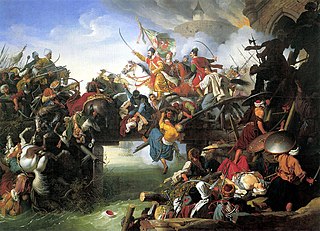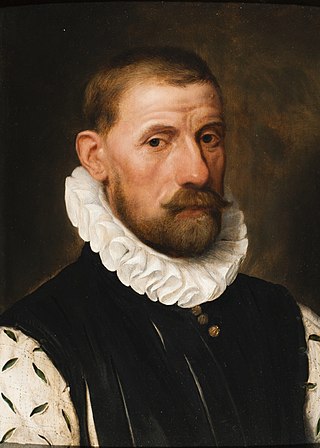
Year 1566 (MDLXVI) was a common year starting on Tuesday of the Julian calendar.

William the Silent or William the Taciturn, more commonly known in the Netherlands as William of Orange, was the leader of the Dutch revolt against the Spanish Habsburgs that set off the Eighty Years' War (1568–1648) and resulted in the formal independence of the United Provinces in 1648. Born into the House of Nassau, he became Prince of Orange in 1544 and is thereby the founder of the Orange-Nassau branch and the ancestor of the monarchy of the Netherlands. In the Netherlands, he is also known as Father of the Fatherland.
Beeldenstorm in Dutch and Bildersturm in German are terms used for outbreaks of destruction of religious images that occurred in Europe in the 16th century, known in English as the Great Iconoclasm or Iconoclastic Fury and in French as the Furie iconoclaste. During these spates of iconoclasm, Catholic art and many forms of church fittings and decoration were destroyed in unofficial or mob actions by Calvinist Protestant crowds as part of the Protestant Reformation. Most of the destruction was of art in churches and public places.

Lamoral, Count of Egmont, Prince of Gavere was a general and statesman in the Spanish Netherlands just before the start of the Eighty Years' War, whose execution helped spark the national uprising that eventually led to the independence of the Netherlands.

The Eighty Years' War or Dutch Revolt was an armed conflict in the Habsburg Netherlands between disparate groups of rebels and the Spanish government. The causes of the war included the Reformation, centralisation, excessive taxation, and the rights and privileges of the Dutch nobility and cities.

Philip de Montmorency, also known as Count of Horn, Horne, Hoorne or Hoorn, was a victim of the Inquisition in the Spanish Netherlands.

The Council of Troubles was the special tribunal instituted on 9 September 1567 by Fernando Álvarez de Toledo, 3rd Duke of Alba, governor-general of the Habsburg Netherlands on the orders of Philip II of Spain to punish the ringleaders of the recent political and religious troubles in the Netherlands. Due to the many death sentences pronounced by the tribunal, it also became known as the Council of Blood. The tribunal would be abolished by Alba's successor Luis de Zúñiga y Requesens on 7 June 1574 in exchange for a subsidy from the States-General of the Netherlands, but in practice it remained in session until the popular revolution in Brussels of the summer of 1576.

Augustus was Elector of Saxony from 1553 to 1586.

The Spanish Fury was a number of violent sackings of cities (lootings) in the Low Countries or Benelux, mostly by Spanish Habsburg armies, that happened in the years 1572–1579 during the Dutch Revolt. In some cases, the sack did not follow the taking of a city. In others, the sack was ordered, or at least not restrained, by Spanish commanders after the fall of a city.

Maria of Austria or Maria of Spain, also known as Isabel, was the empress consort and queen consort of Maximilian II, Holy Roman Emperor, King of Bohemia and Hungary. She served as regent of Spain in the absence of her father Emperor Charles V from 1548 until 1551 and was one of the most powerful empresses of the Holy Roman Empire.
Robert Beaumont was Master of Trinity College, Cambridge from 1561 to 1567 and twice Vice-Chancellor of the University of Cambridge. During this time, he commissioned Hans Eworth to copy the 1537 Hans Holbein portrait of King Henry VIII. This copy was bequeathed to Trinity College where it hangs to this day.

Giovanni Francesco Commendone was an Italian cardinal and papal nuncio.
Walter Haddon LL.D. (1515–1572) was an English civil lawyer, much involved in church and university affairs under Edward VI, Queen Mary, and Elizabeth I. He was a University of Cambridge humanist and reformer, and was highly reputed in his time as a Latinist. He sat as an MP during the reigns of Mary and Elizabeth. His controversial exchange with the Portuguese historian Jerónimo Osório attracted international attention partly on account of the scholarly reputations of the protagonists.
Philippe René Nivelon Louis de Sainte-Aldegonde, Lord of Noircarmes was a statesman and soldier from the Habsburg Netherlands in the service of Charles V, Holy Roman Emperor, and Philip II of Spain. He gained notoriety during the suppression of Calvinist insurrections, especially at Valenciennes in 1566-7, and as a member of the Council of Troubles at the start of the Eighty Years' War. He was stadtholder of Hainaut from 1566, and of Holland, Zeeland and Utrecht from 1573 until his death.

The Compromiseof Nobles was a covenant of members of the nobility in the Habsburg Netherlands who came together to submit a petition to the Regent Margaret of Parma on 5 April 1566, with the objective of obtaining a moderation of the placards against heresy in the Netherlands. This petition played a crucial role in the events leading up to the Dutch Revolt and the Eighty Years' War.

Liever Turks dan Paaps, also Liever Turksch dan Paus, was a Dutch Christian slogan during the Dutch Revolt of the end of the 16th century. The slogan was used by the Dutch mercenary naval forces in their fight against Catholic Spain.
Martin Bauwens of Riethoven or Martinus Rythovius was a Catholic theologian and the first Bishop of Ypres. He was a figure of some spiritual and political significance during the early decades of the Dutch Revolt.

The period between the Capture of Brielle and the Pacification of Ghent was an early stage of the Eighty Years' War between the Spanish Empire and groups of rebels in the Habsburg Netherlands.

The period between the start of the Beeldenstorm in August 1566 until early 1572 contained the first events of a series that would later be known as the Eighty Years' War between the Spanish Empire and disparate groups of rebels in the Habsburg Netherlands. Some of the first pitched battles and sieges between radical Calvinists and Habsburg governmental forces took place in the years 1566–1567, followed by the arrival and government takeover by Fernando Álvarez de Toledo, 3rd Duke of Alba with an army of 10,000 Spanish and Italian soldiers. Next, an ill-fated invasion by the most powerful nobleman of the Low Countries, the exiled but still-Catholic William "the Silent" of Orange, failed to inspire a general anti-government revolt. Although the war seemed over before it got underway, in the years 1569–1571, Alba's repression grew severe, and opposition against his regime mounted to new heights and became susceptible to rebellion.
The origins of the Eighty Years' War are complicated, and have been a source of disputes amongst historians for centuries.